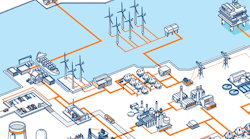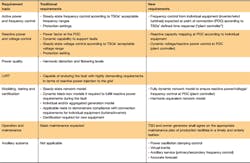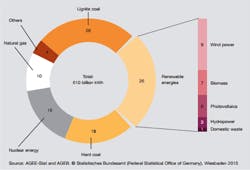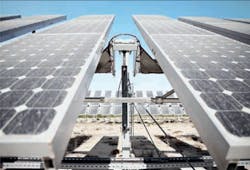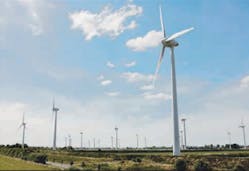Through onshore and offshore power connections, the presence of renewables is a reality today in both transmission and distribution networks, coexisting with and/or substituting more and more conventional generation. Wide experience in the renewables sector and a large number of projects performed worldwide allow ABB experts to offer customers high-level technical and economical assessments to cope with these changing demands and requirements.
Evolution of grid codes
The increasing penetration of large amounts of renewable energy in transmission and distribution networks during the last decades has increased the concerns of TSOs and DSOs, who need to guarantee a continuous and reliable power supply in the grid.
The concerns include:
- Continuity: The uncertainty related to the unpredictable capability of renewables may have an impact on the grid stability and therefore on the continuity of supply.
- Quality of supply: Introducing new technology and connecting to lower shortcircuit networks may result in higher harmonic emissions, voltage fluctuations and resonances. Reactive power capability is also critical in order to guarantee acceptable voltage levels.
- Reliable and secure supply: Disconnection of large amounts of renewable resources may impact the overall stability of the grid. Available spinning reserve is needed to ensure a secure operation.
Grid codes traditionally focused on static reactive-power control, power factor and dynamic requirements such as low-voltage ride-through (LVRT) capability. The codes are now evolving into more demanding requirements including dynamic control of reactive-power, voltage and frequency at the point of connection, and power quality – ie, full control of the facility. The key changes from the TSO perspective are outlined in ➔ 1. Challenges to various distribution systems in different countries are presented in [1].
Grids with low potential for growth in energy consumption
North America and Europe have experienced progressive renewable penetration during the past two decades. Environmental concerns and political regulations, in parallel with available technology, are the main drivers for the change. Transmission power networks are well interconnected, robust and dimensioned with sufficient reactive power margins and spinning reserve to be correctly balanced. In addition, well-known operational and market rules exist. To keep pace with the ambitious targets for 2020 and 2050 these networks are facing three main challenges. Specifically how to:
- Reinforce/adapt the existing power networks to allocate more renewable resources
- Integrate and control renewable generation in the distribution grid
- Cope with the expected new requirements from TSOs/DSOs for voltage control and frequency regulation.
United States
The installation of renewable energy, particularly wind energy in the United States, has often required reinforcement of the transmission infrastructure. One example is the transmission system within the Texas Interconnection with the Electric Reliability Council of Texas (ERCOT) as the system operator. In 2005, the Texas Legislature ordered the Public Utility Commission of Texas to designate Competitive Renewable Energy Zones (CREZ) and to order specific transmission improvements that would allow connections from the CREZ to load centers primarily around the Dallas/Fort Worth metroplex, Austin and San Antonio [2].
This reinforcement included over 3,700 km of new 345 kV transmission lines to accommodate an incremental 11,500 MW of wind generation capacity in western areas of the state. ABB performed an initial reactive power assessment in 2009 concluding at the outset with nearly 4000 MVAr of shunt reactors, about 960 MVAr of shunt capacitors, and 1,400 MVAr of static var compensators (SVCs).
With regard to grid codes, there are some special provisions for renewable developers to comply with Federal Energy Regulatory Commission (FERC) Order 661-A for LVRT and reactive capability requirements, in addition to the general standards applicable to all power generation.
Spain
Spain has been a leader of renewable integration for the past 15 years. A new draft for the local grid code is under discussion in which, on top of the traditional requirements, frequency regulation and voltage control are being considered.
Providing flexibility to the existing networks to maximize the use of the installed renewable capacity (about 23 GW vs. a peak load of about 40 GW) is a challenge today. Flexible AC transmission solutions (FACTS), energy storage and increasing the interconnecting capacity with HVDC are some solutions under study. ABB, in collaboration with the Spanish TSO Red Eléctrica de España (REE), has participated in the EU TWENTIES consortium, contributing with an important package of R&D studies to develop a real prototype [3] capable of redirecting the excess of renewable power flowing from one corridor to another with available capacity.
Germany
In Germany, over 1 million small generators are already connected to the distribution grid. Wind turbines and photovoltaics (PV) represent a total installed capacity of more than 76 GW, related to a peak load of about 80 GW ➔ 2. Initially, small-sized generators were not required to be equipped with communication technology or remote control access. Today, the situation is the opposite. In the event of power quality problems, the grid operator is empowered to reduce feedin. In general, fluctuating generators create challenges to keep the voltage within the defined band and the thermal load of assets is also a challenge.
In Germany, rules issued by Bundesverband der Energie- und Wasserwirtschaft (BDEW) and Verband der Elektrotechnik Elektronik Informationstechnik e.V. (VDE) cover grid codes for generators and storage in distribution system. ENTSO-E network codes such as “Requirements for generators” are also expected to become effective for Europe soon [4, 5]. ABB has been a pioneer in developing innovative components such as voltage regulators to solve individual challenges of power quality for distribution grid operators [6, 7].
United Kingdom
In the United Kingdom, apart from solar panels installed on domestic rooftops, the rest of the renewable infeed is large enough to follow the grid code, with which National Grid and users of its transmission system are required to comply. The UK electrical network (especially the southern part of it) has one of the highest electric energy densities in the world, causing a lot of difficulties when designing power plant networks and achieving grid code targets. High short-circuit levels; the need for power transformers with high impedance; voltage stability and power quality issues; and fast fault clearance demand are some of the challenges.
Grids with high potential for growth in energy consumption
In South America, the Middle East and Asia the networks continue to develop at the same time that a large integration of renewables is taking place, driven mainly by available technology, more accessible electricity prices, and investors bringing in successful experiences from other countries. The challenges of integration are:
- Stability issues due to limited margins of reactive power
- Lack of interconnection with neighboring countries and limited spinning reserve
- Poor power quality levels due to low short-circuit ratios
- Networks generally weaker in the areas away from the main cities
South Africa
ABB has participated in numerous local studies, exporting expertise worldwide [8].
Recently ABB experts have faced the challenge of developing a high-level plant controller in South Africa able to fulfill the new grid code requirements from Eskom in terms of voltage, power factor, reactive power control and power curtailment in a very short time ➔ 3.
Brazil
In Brazil figures for wind and solar power generation in 2013 were 28 percent and 5 percent, respectively. The rapid integration of renewables is bringing new challenges in terms of power plant design and operation. To comply with the Brazilian ISO (ONS – Operador Nacional do Sistema Elétrico) grid code, ABB has been working on assuring appropriate modeling for wind turbine control ➔ 4 and providing solutions to improve power quality.
The ISO has been tracking measurement campaigns and participated in task force working groups to share and develop methodologies to define the grid code in terms of filtering optimization.
Jordan
Jordan is facing a serious challenge on the energy front. It imports more than 97 percent of its energy, leading to high energy bills. This situation highlights the need to utilize alternate sources of energy, which are abundant in the country. The country aims to raise its dependency on local and renewable energy resources from 4 percent (in 2013) to 13 percent by 2016 and 39 percent by 2020.
ABB has studied the market trends, expectations and the renewables grid code to leverage opportunities posed by the booming renewable sector. The market has been approached proactively, an initiative that has been very well received by NEPCO, the transmission utility and renewable investors. Promoters have now approached ABB to extend grid integration support in Egypt. To get approval to connect the proposed RE plant to the grid, RE developers have to comply with all the requirements as per the grid code, something which ABB is well placed, and well experienced, to help them do.
Code connection
For many power network providers, keeping up with the ever changing and increasingly demanding grid codes is a draw on resources. It takes time to keep up, and to interpret changing or new grid codes, and to then extrapolate how those codes may affect the situation and what may need to change in order to remain compliant. ABB supports power providers through these changes, and their vast experience brings clarity and effectiveness to the review, assessment and decision making activities required.
Changing and evolving grid codes are necessary for changing and evolving grid supply and demand. But rather than these changes being a burden, ABB sees them as a positive opportunity for grid evolution: Much like the Chinese proverb that says, “When the winds of change blow, some people build walls and others build windmills.”
Inés Romero
ABB Power Consulting
Madrid, Spain
[email protected]
Fahd Hashiesh
ABB Power Consulting
Stone, United Kingdom
[email protected]
John Daniel
ABB Power Consulting
Raleigh, NC, United States
[email protected]
Nihar Raj
ABB Power Consulting
Vadodara India
[email protected]
Diogo Pereira
ABB Power Consulting
Guarulhos, Brazil
[email protected]
Britta Buchholz
ABB Power Consulting
Mannheim, Germany
[email protected]
------------------------------------
References
[1] J. S. Papathanassiou et al., “Capacity of Distribution Feeders for Hosting DER“ in CIGRE, Technical Brochure 586. Paris, 2014.
[2] J. Daniel et al. (2010). “CREZ Reactive Power Compensation Study.” Available: http://www.uwig.org/CREZ_ Reactive_Power_Compensation_Study.pdf
[3] I. Romero et al., “Overload line controller: new FACTS series compensation application based on switched series reactors” in CIGRE, session A3-108. Paris, 2014.
[4] ENTSO-E (2015). Network Code on Requirements for Grid Connection Applicable to all Generators (RfG) [Online]. Available: https://www.entsoe.eu/majorprojects/network-code-development/ requirements-for-generators/Pages/default.aspx
[5] Federal Ministry for Economic Affairs and Energy (BMWi). “Development of Renewable Energy Resources in Germany 2014”, Berlin, 2015.
[6] B. Buchholz et al., “Smarter distribution: How to increase the capacity of distribution grids to host distributed generation,” ABB Review 4/2014, pp. 29–33.
[7] M. Carlen, et al., “Regulating life’s ups and downs : Increasing grid capacity to connect renewable energies,” ABB Review 4/2015, pp. 34–41.
[8] I. Romero Navarro, et al., “Wind Farm Integration Power Analysis“ in Power-Gen Asia, Singapore, 2007.
